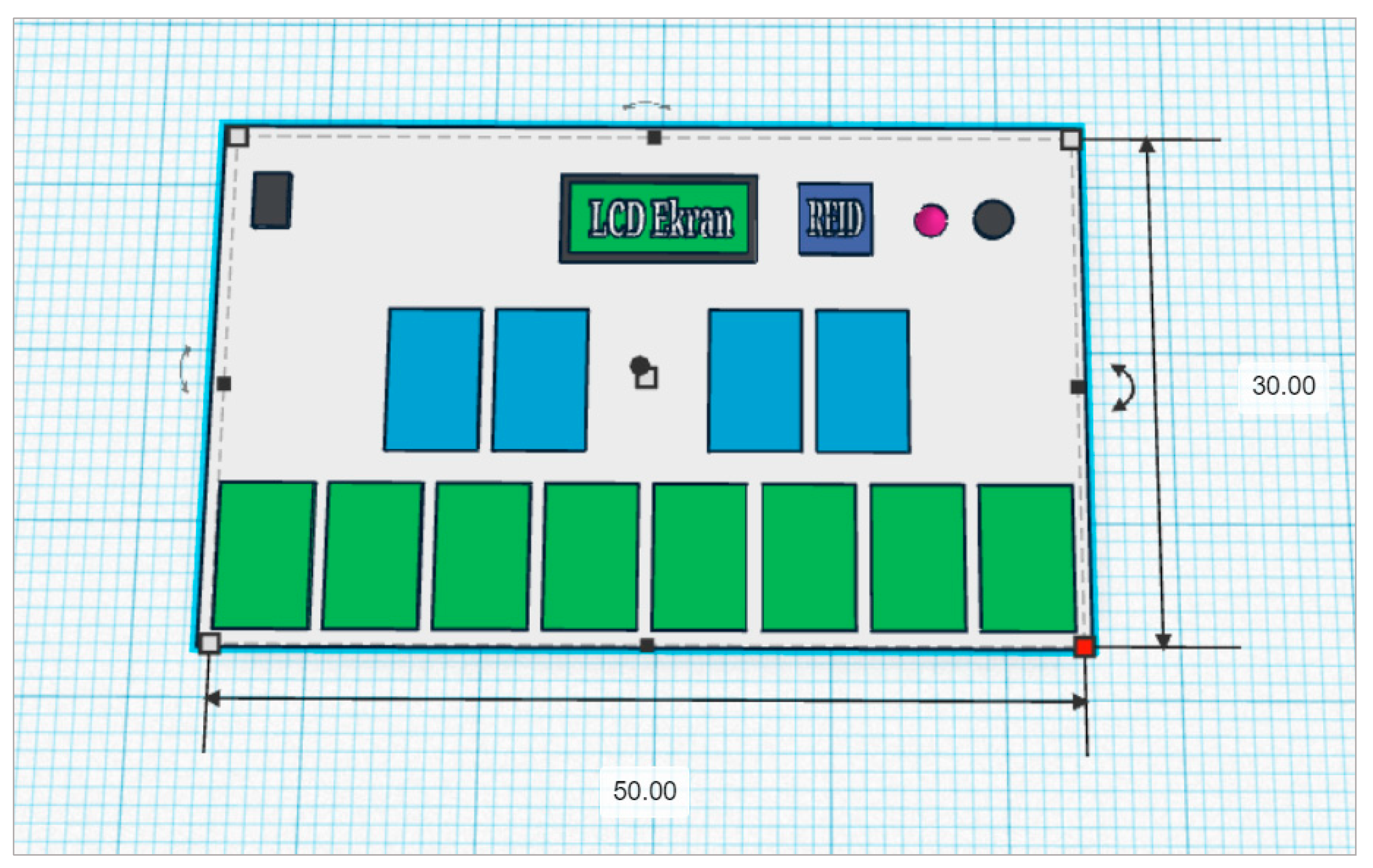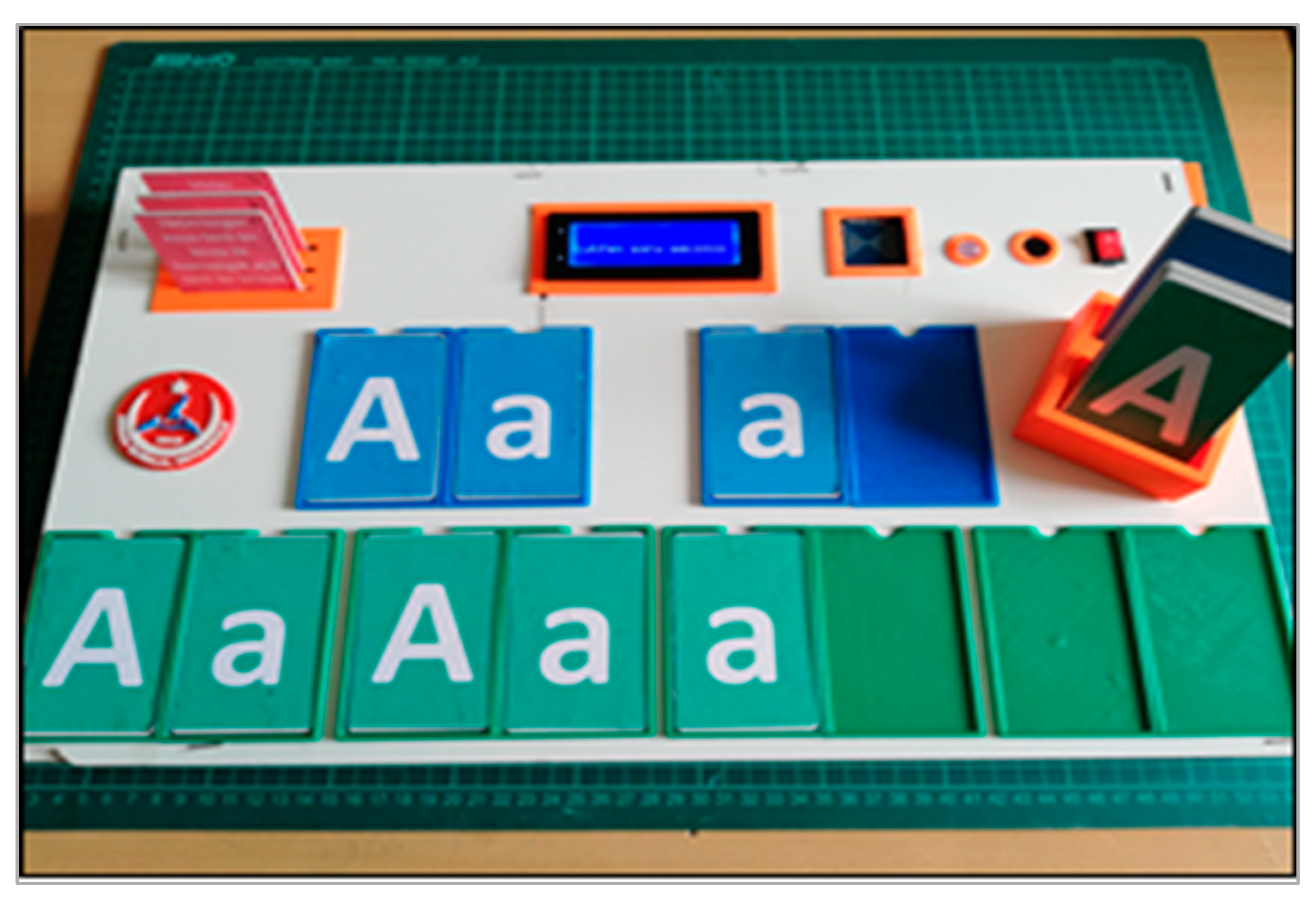Investigating the Influence of an Arduino-Based Educational Game on the Understanding of Genetics among Secondary School Students
Abstract
1. Introduction
2. Conceptual Framework
3. Materials and Methods
3.1. Research Design
3.2. Participants
3.3. Procedure
3.4. Data Collection
3.5. Material Development
4. Results
5. Discussion
6. Conclusions
Author Contributions
Funding
Institutional Review Board Statement
Informed Consent Statement
Data Availability Statement
Acknowledgments
Conflicts of Interest
References
- Arpaci, I. A Comparative Study of the Effects of Cultural Differences on the Adoption of Mobile Learning. Br. J. Educ. Technol. 2015, 46, 699–712. [Google Scholar] [CrossRef]
- Kırtay, A. The Effect of Robotic Applications on Students’ Science Process Skills and Motivation in Science Education. Master’s Thesis, Mersin University, Mersin, Turkey, 2019. [Google Scholar]
- Al-Emran, M.; Al-Nuaimi, M.N.; Arpaci, I.; Al-Sharafi, M.A.; Anthony Jnr., B. Towards a Wearable Education: Understanding the Determinants Affecting Students’ Adoption of Wearable Technologies Using Machine Learning Algorithms. Educ. Inf. Technol. 2023, 28, 2727–2746. [Google Scholar] [CrossRef]
- Arpaci, I.; Basol, G. The Impact of Preservice Teachers’ Cognitive and Technological Perceptions on Their Continuous Intention to Use Flipped Classroom. Educ. Inf. Technol. 2020, 25, 3503–3514. [Google Scholar] [CrossRef]
- Shulman, L.S. Making Differences: A Table of Learning. Chang. Mag. High. Learn. 2002, 34, 36–44. [Google Scholar] [CrossRef]
- Hake, R.R. Interactive-Engagement versus Traditional Methods: A Six-Thousand-Student Survey of Mechanics Test Data for Introductory Physics Courses. Am. J. Phys. 1998, 66, 64–74. [Google Scholar] [CrossRef]
- Koç, A. The Comparison of Stem Implementations with Robotic-Assisted and Simple Materials in Preschool and Basic Science Education. Ph.D. Thesis, Erciyes University, Kayseri, Turkey, 2019. [Google Scholar]
- Bayraklı, S. Content Analysis of Master Theses Which Were Conducted with Experimental Research in Science Education between the Years of 2008–2018. Master’s Thesis, Marmara University, Istanbul, Turkey, 2019. [Google Scholar]
- Vasconcelos, C.; Orion, N. Earth Science Education as a Key Component of Education for Sustainability. Sustainability 2021, 13, 1316. [Google Scholar] [CrossRef]
- Zhang, W.; Wang, Z. Theory and Practice of VR/AR in K-12 Science Education—A Systematic Review. Sustainability 2021, 13, 12646. [Google Scholar] [CrossRef]
- Trott, C.D.; Weinberg, A.E. Science Education for Sustainability: Strengthening Children’s Science Engagement through Climate Change Learning and Action. Sustainability 2020, 12, 6400. [Google Scholar] [CrossRef]
- Schönfelder, M.L.; Bogner, F.X. Between Science Education and Environmental Education: How Science Motivation Relates to Environmental Values. Sustainability 2020, 12, 1968. [Google Scholar] [CrossRef]
- Al-Emran, M.; Arpaci, I.; Salloum, S.A. An Empirical Examination of Continuous Intention to Use M-Learning: An Integrated Model. Educ. Inf. Technol. 2020, 25, 2899–2918. [Google Scholar] [CrossRef]
- Palomares-Ruiz, A.; Cebrián, A.; López-Parra, E.; García-Toledano, E. ICT Integration into Science Education and Its Relationship to the Digital Gender Gap. Sustainability 2020, 12, 5286. [Google Scholar] [CrossRef]
- Şentürk, M. The Investigation with Solomon Four-Group Design on the Effect of Using Mobile Augmented Reality (AR) Applications in the Unit Titled Solar System and beyond in the Seventh-Grade on the Students’ Academic Success, Motivation, Science and Technology Attitude. Master’s Thesis, Kocaeli University, Kocaeli, Turkey, 2018. [Google Scholar]
- Karataş, K.; Arpaci, I.; Yildirim, Y. Predicting the Culturally Responsive Teacher Roles with Cultural Intelligence and Self-Efficacy Using Machine Learning Classification Algorithms. Educ. Urban Soc. 2022, 001312452210879. [Google Scholar] [CrossRef]
- Al-Sharafi, M.A.; Al-Emran, M.; Iranmanesh, M.; Al-Qaysi, N.; Iahad, N.A.; Arpaci, I. Understanding the Impact of Knowledge Management Factors on the Sustainable Use of AI-Based Chatbots for Educational Purposes Using a Hybrid SEM-ANN Approach. Interact. Learn. Environ. 2022, 1–20. [Google Scholar] [CrossRef]
- Solé-Llussà, A.; Casanoves, M.; Salvadó, Z.; Garcia-Vallve, S.; Valls, C.; Novo, M. Annapurna Expedition Game: Applying Molecular Biology Tools to Learn Genetics. J. Biol. Educ. 2019, 53, 516–523. [Google Scholar] [CrossRef]
- Hussein, M.H.; Ow, S.H.; Elaish, M.M.; Jensen, E.O. Digital Game-Based Learning in K-12 Mathematics Education: A Systematic Literature Review. Educ. Inf. Technol. 2022, 27, 2859–2891. [Google Scholar] [CrossRef]
- Chen, C.-H.; Shih, C.-C.; Law, V. The Effects of Competition in Digital Game-Based Learning (DGBL): A Meta-Analysis. Educ. Technol. Res. Dev. 2020, 68, 1855–1873. [Google Scholar] [CrossRef]
- Bressler, D.M.; Shane Tutwiler, M.; Bodzin, A.M. Promoting Student Flow and Interest in a Science Learning Game: A Design-Based Research Study of School Scene Investigators. Educ. Technol. Res. Dev. 2021, 69, 2789–2811. [Google Scholar] [CrossRef]
- Chen, C.-H.; Law, V.; Chen, W.-Y. The Effects of Peer Competition-Based Science Learning Game on Secondary Students’ Performance, Achievement Goals, and Perceived Ability. Interact. Learn. Environ. 2018, 26, 235–244. [Google Scholar] [CrossRef]
- Annetta, L.A.; Minogue, J.; Holmes, S.Y.; Cheng, M.-T. Investigating the Impact of Video Games on High School Students’ Engagement and Learning about Genetics. Comput. Educ. 2009, 53, 74–85. [Google Scholar] [CrossRef]
- Chen, C.-H.; Law, V.; Huang, K. The Roles of Engagement and Competition on Learner’s Performance and Motivation in Game-Based Science Learning. Educ. Technol. Res. Dev. 2019, 67, 1003–1024. [Google Scholar] [CrossRef]
- Casanoves, M.; Solé-Llussà, A.; Haro, J.; Gericke, N.; Valls, C. Assessment of the Ability of Game-Based Science Learning to Enhance Genetic Understanding. Res. Sci. Technol. Educ. 2022, 1–23. [Google Scholar] [CrossRef]
- Chen, C.-H. Impacts of Augmented Reality and a Digital Game on Students’ Science Learning with Reflection Prompts in Multimedia Learning. Educ. Technol. Res. Dev. 2020, 68, 3057–3076. [Google Scholar] [CrossRef]
- Creswell, J.W.; Creswell, J.D. Research Design: Qualitative, Quantitative, and Mixed Methods Approaches; Sage Publication, Inc.: Thousand Oaks, CA, USA, 2018. [Google Scholar]
- Yüksel, B. The Effects of Programming with Arduino the 6th Grade Students’ Achievements, Attitudes and Self-Sufficiency Intended for Science. Master’s Thesis, Bulent Ecevit University, Zonguldak, Turkey, 2019. [Google Scholar]
- Yıldırım, D. Testing the Effect of Gamification on the Success of Year 5th Grade Students’ Social Science Course Learning. Master’s Thesis, Bahçeşehir University, Istanbul, Turkey, 2018. [Google Scholar]
- Doğan, E. The Impact of Instruction through Digital Games on Students’ Academic Achievement in Teaching Earthquakes in a Social Science Class. Master’s Thesis, Sivas University, Sivas, Turkey, 2017. [Google Scholar]



| Group | N | Female | Male | Total% | ||
|---|---|---|---|---|---|---|
| F | % | F | % | |||
| Experimental 1 | 18 | 12 | 66.6 | 6 | 33.4 | 25 |
| Experimental 2 | 18 | 10 | 55.5 | 8 | 44.5 | 25 |
| Control 1 | 18 | 11 | 61.1 | 7 | 38.9 | 25 |
| Control 2 | 18 | 9 | 50 | 9 | 50 | 25 |
| Total | 72 | 42 | 30 | 100 | ||
| Statistic | D.F. | Significance (p) | |
|---|---|---|---|
| Pre-test | 0.142 | 36 | 0.063 |
| Post-test | 0.132 | 36 | 0.116 |
| Group | N | Mean | S.D. | S.E. | t | p | Cohen’s d | Effect-Size r |
|---|---|---|---|---|---|---|---|---|
| Experimental 1 | 18 | 42.22 | 15.17 | 3.57 | −0.137 | 0.892 | 0.046 | 0.023 |
| Control 1 | 18 | 43.06 | 20.87 | 4.91 |
| Group-Test | N | Mean | S.D. | S.E. | t | p | Cohen’s d | Effect-Size r |
|---|---|---|---|---|---|---|---|---|
| Experimental 1-pre-test | 18 | 42.22 | 15.17 | 3.58 | 16.35 | 0.000 | 1.047 | 0.464 |
| Experimental 1-post-test | 18 | 58.06 | 15.06 | 3.55 | ||||
| Control 1-pre-test | 18 | 43.06 | 20.87 | 4.92 | 12.49 | 0.000 | 0.678 | 0.321 |
| Control 1-post-test | 18 | 56.67 | 19.25 | 4.54 |
| Group | N | Mean | S.D. | S.E. | t | p | Cohen’s d | Effect-Size r |
|---|---|---|---|---|---|---|---|---|
| Experimental 1 | 18 | 58.05 | 15.06 | 3.55 | 0.241 | 0.811 | 0.080 | 0.040 |
| Control 1 | 18 | 56.66 | 19.25 | 4.53 | ||||
| Experimental 2 | 18 | 58.61 | 20.78 | 4.89 | 0.636 | 0.529 | 0.212 | 0.105 |
| Control 2 | 18 | 54.44 | 18.46 | 4.35 | ||||
| Experimental 1 | 18 | 58.05 | 15.06 | 3.55 | −0.092 | 0.927 | 0.031 | 0.015 |
| Experimental 2 | 18 | 58.61 | 20.78 | 4.89 |
Disclaimer/Publisher’s Note: The statements, opinions and data contained in all publications are solely those of the individual author(s) and contributor(s) and not of MDPI and/or the editor(s). MDPI and/or the editor(s) disclaim responsibility for any injury to people or property resulting from any ideas, methods, instructions or products referred to in the content. |
© 2023 by the authors. Licensee MDPI, Basel, Switzerland. This article is an open access article distributed under the terms and conditions of the Creative Commons Attribution (CC BY) license (https://creativecommons.org/licenses/by/4.0/).
Share and Cite
Arpaci, I.; Kaya, A.; Bahari, M. Investigating the Influence of an Arduino-Based Educational Game on the Understanding of Genetics among Secondary School Students. Sustainability 2023, 15, 6942. https://doi.org/10.3390/su15086942
Arpaci I, Kaya A, Bahari M. Investigating the Influence of an Arduino-Based Educational Game on the Understanding of Genetics among Secondary School Students. Sustainability. 2023; 15(8):6942. https://doi.org/10.3390/su15086942
Chicago/Turabian StyleArpaci, Ibrahim, Abdullah Kaya, and Mahadi Bahari. 2023. "Investigating the Influence of an Arduino-Based Educational Game on the Understanding of Genetics among Secondary School Students" Sustainability 15, no. 8: 6942. https://doi.org/10.3390/su15086942
APA StyleArpaci, I., Kaya, A., & Bahari, M. (2023). Investigating the Influence of an Arduino-Based Educational Game on the Understanding of Genetics among Secondary School Students. Sustainability, 15(8), 6942. https://doi.org/10.3390/su15086942






